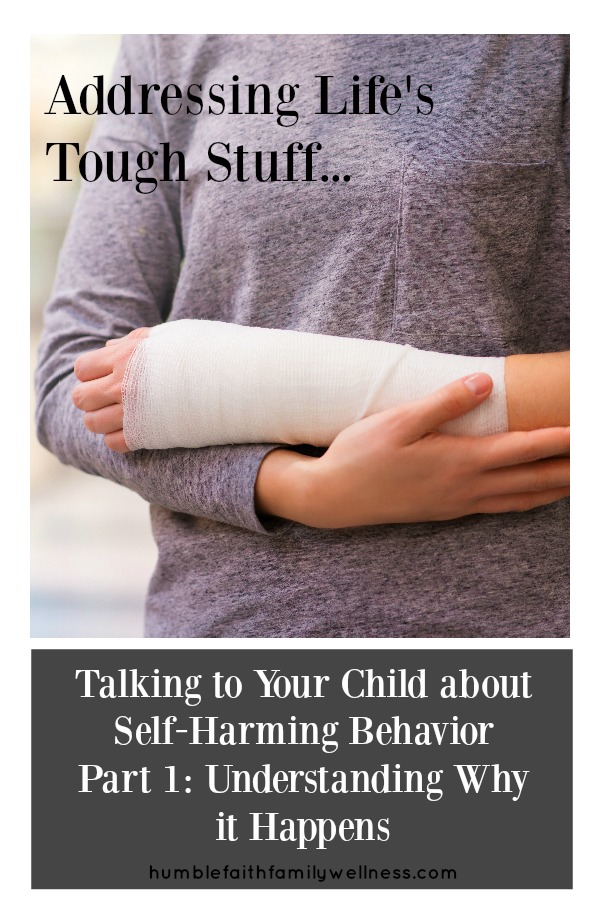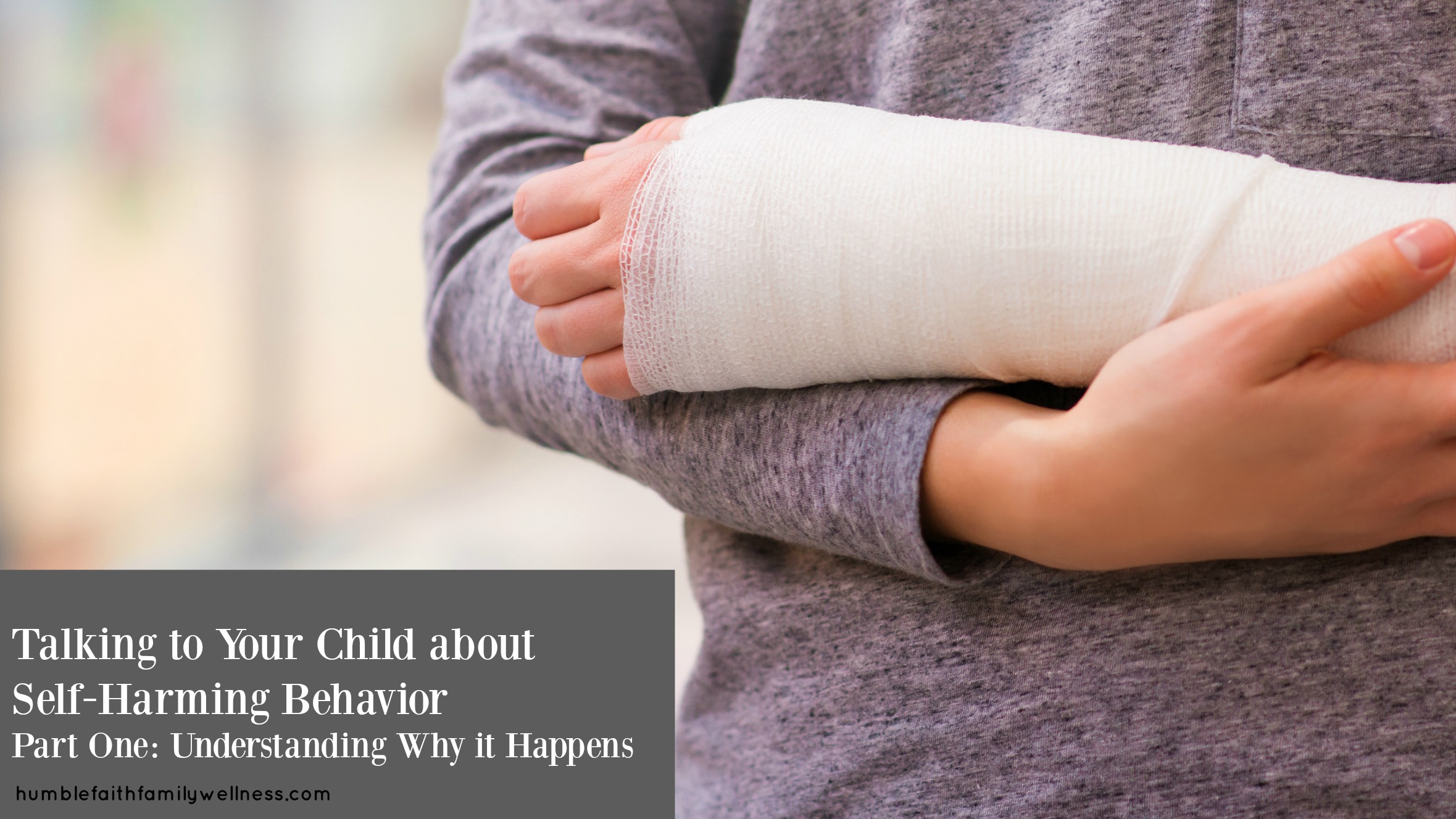
As a therapist, parents ask me how to talk to their kids about all the tough stuff topics. My goal for this series is to address each of these topics and help you and your child navigate the more difficult areas of life.
This post is part one in how to talk to your child about self-harming behavior. Part one will explain why self-harming behavior happens and how to talk to your child about it.
Here’s a list of other tough stuff topics that I have addressed or will be in the future:
- How to talk to your kids about sex
- Talking to your child about inappropriate touching.
- Talking to your child about pornography
- Discussing the Purpose of Dating
- Self-harming Part 1 – Understanding why it happens
- Self-harming Part 2 – How to react if your child self-harms
- Suicide Part 1 – Understanding why it happens
- Suicide Part 2 – As a parent how to react if your child is suicidal
- Talking to your teens about drinking
- Talking to your teens about drugs
- How to teach your teens to follow their values – Part One
- How to teach your teens to follow their values -Part Two …And not be judgmental
Unfortunately, self-harming behavior has become “popular” to some regard. And in the eight years of being a therapist, I’ve worked with probably hundreds of kids of all ages who have engaged in the behavior. It’s essential to have an understanding of why it happens so that you, as a parent, can explain this behavior to your child.
Statistics
- Each year, 1 in 5 females and 1 in 7 males engage in self-injury
- 90 percent of people who engage in self-harm begin during their teen or pre-adolescent years
- Nearly 50 percent of those who engage in self-injury activities have been sexually abused
- Females comprise 60 percent of those who engage in self-injurious behavior
- About 50 percent of those who engage in self-mutilation begin around age 14 and carry on into their 20s
- Many of those who self-injure report learning how to do so from friends or pro-self-injury websites
Approximately two million cases are
reported
- annually in the U.S. (Source)
Self-harming is NOT for the intention of killing themselves
According to the National Alliance of Mental Illness (NAMI), one of the most common types of self-harm is cutting, but there are many other types of self-injury including burning or punching the body or picking skin or sores.
One of the most common misconceptions is that all self-harming behavior is with the intent of ending their life. That is not the case. And there is a significantly different thought and emotional process between the two. Generally, a person engages in self-harming behavior for one of three reasons and a combination of these three.
1. Distraction from Emotional Pain
For some kids their emotional pain is significant. They either have experienced a past of trauma, or there is a situational event that they don’t know how to handle or manage. When a person experiences physical pain, it can act as a distraction from the emotional pain. The physical pain can block out thoughts, and the emotions seem to lessen. That is also because when the body gets physically hurt it releases endorphins interact with the receptors in your brain that reduce your perception of pain.
Unfortunately, this is effective. Not healthy, safe, functional, or appropriate. But effective in the moment.
2. An Ability to Feel Something if Emotionally Numb
On the opposite end of the coin, some of my past clients have expressed struggling to be able to feel anything. Also either due to trauma or depression, they can express feeling flat, numb, or blunted. They then describe the use of self-harm as a way to “feel something.”
I have had various past clients say something like, “I felt so dead inside that self-harming helped me to feel alive.” That was not a rational thought, and we worked extensively on how to fight against those thoughts.
But this is an example of how different the thought process is with self-harming behavior versus someone who is suicidal.
Unfortunately, this is also effective. Again, don’t get me wrong, I am in no way endorsing the use of self-harm. But that’s what makes it so difficult to stop. It is effective at doing what they want it to do at the moment.
3. A Way to Punish – Shame
Shame is a strong reason people start to self-harm. Feeling like they deserve to suffer and punishing themselves for other behaviors. Shame about body issues, a breakup, not measuring up to their standards, etc. There are many issues, generally surrounding self-worth, that leads a person to self-harm.
This thought process can be the most difficult to work through because often they don’t believe they are worth taking care of. There then is an issue of motivation to follow through on treatment.
Secondary Gain – “Attention-Seeking”
Unfortunately, “attention-seeking” often gets viewed as the main reason why a person engages in self-harm.
That has not been my experience in working with this issue.
However, receiving attention, increased support and time from friends and families can create secondary gain. Meaning, the self-harming behavior may not have initially started for attention. However, it may reinforce the behavior.
I will address how to react to self-harming behavior in part two.
Unintended Consequence – Death
Once a person begins self-harming, it can become addictive. They can start to crave the endorphin release. So the frequency in which they engage in the behavior increases.
And just like any other addictive behavior, the body begins to build up a tolerance. Therefore, to experience the same level of “relief,” they end up having to harm themselves more intensely.
That is then how self-harming behavior can lead to accidental death. Having cut too deep on a major vein and not then seeking immediate help.
How to talk to your kids about self-harming
- Be proactive and upfront.
- Share with them the danger, risks, and addictive properties of self-harming.
- Let them know your love and desire always to support them. No matter what!
- Ask how self-harming is viewed at their school or group of friends.
- Ask if they know anyone or have any friends that self-harm.
I pray this post helps you to understand better why self-harming behavior happens and for you to feel better equipped to talk to your child about this ‘tough stuff topic.’
Also please let me know in the comments below of any other ‘tough stuff’ topic you would like me to address to help you have discussions with your children.
God bless!
Melissa
p.s. Check out all of the beautiful sites I link up with!
*Disclosure: This post may contain affiliates. Read the full disclosure here.

Unfortunately I have had anumber of students over the years with hundreds, even thousands of little scars nicked into their skin. It always grieves me to the core.
It is tremendously sad that they get to a place of pain and feel they have no other way or option to handle their distress but to harm themselves. And even more sad is the fact that our society has come to normalize the behavior.
I knew a few girls that did this during school. I didn’t know the reasons behind but it makes sense! Thank you for covering these topics!
Unfortunately it does make sense and even “works” in the moment but has significantly negative ramifications. Thank YOU for stopping by and reading about these tough topics. God bless, Julie!
This is such an important topic. I worked in a treatment facility that was home to numerous cutters. Their families were bewildered trying to understand and help their children. Thank you for offering crucial help!
Thank you Kelly! And thank YOU for working with people in need. Self-harming behavior is not often discussed or it’s lumped in with suicidal thoughts and behaviors. Thank you for stopping by and sharing your experience. God bless!
Oh! This speaks to me. I had this issue when I was a teen. I’m not sure how to describe why I would, but I’m certain it wasn’t for attention. My mom and I are VERY different people and I felt as though I was battling between what she wanted me to be and who I was. I think it was a way to deal with the pent up emotions that I didn’t want to release on her, out of respect that she was my mom. <3 It's my mission to never build a wall between my boys and myself. An open line of communication will give them the ability to approach me with concerns, no matter the issue. (at leas this is my prayer) I hope that open line will help with the "want" to inflict harm on themselves. <3 Thank you for sharing Melissa! I always find your articles extremely insightful and help me understand things I went through.
I’m so sorry this is something you went through, Katie! This is the exact reason I described the self-reflection of area for parents to ensure they are letting their children know they love and always want to support them no matter the situation. Thank you so much Katie for sharing your personal experience of self-harming behavior. God bless!
This is such a hard topic to cover. I remember having friends who self-harmed in high school. It was hard for someone who didn’t understand to support them. But they knew I at least tried, their parents didn’t understand at all. Fast-forward to today, I wonder if the parent’s cared so much it was hard to cope.
I work with many parents that struggle significantly when their children are self-harming. They feel guilt, confusion, pain, and some anger. Next week’s post will walk through how to react if you find out your child is self-harming. Thank you for stopping by Heather. God bless!
Thank you for addressing a difficult topic. Learning how to respond to someone that has self-injured is key. Yes, it can be shocking but staying calm is crucial. I think one can focus too much on the act behavior trying to get the person to stop when what is needed is to get to the root of the problem. What is hurting them? Recognizing the person is in great pain on the inside. We ended up seeing the self-injury as a roadmap into the heart of the person. Learning how to respond to a person that has self-injured can make a huge difference in getting them the help they need.
So true about addiction and it happens fast. Especially, because self-injury releases endorphins and leaves the person feeling better in the short term. However, it is a horrible coping skill for the long run. On my website, I have some great book listed on my mental health resource page.
Thank you for sharing with Grace & Truth. I look forward to part two.
Yes, staying calm is crucial. In part two I will go into helping a parent react to the situation if they realize their child is self-harming. Thank you so much for stopping by and sharing your thoughts and access to your book resources. God bless!